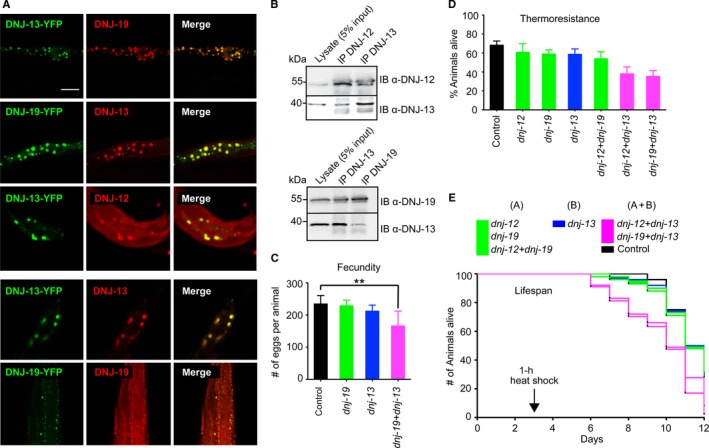Figure 3.

Mixed‐class J‐protein cooperation is stress responsive and vital for organismal health and viability. (A) Co‐localization of immunofluorescence (yellow) of DNJ‐12 (A), DNJ‐13 (B), or DNJ‐19 (A) using Alexa Fluor 594‐labeled antibodies (red), and stably expressed C‐terminal YFP‐tagged (green) DNJ‐13 (B) or DNJ‐19 (A) in Caenorhabditis elegans after 4 h recovery at 20 °C post‐heat shock. Fluorescent images depict the head region of nematodes. Scale bar = 20 μm. Bottom two panels show the specificity of antibody recognition for DNJ‐13 and DNJ‐19. (B) DNJ‐12, DNJ‐13, DNJ‐19 co‐immunoprecipitate from non‐heat shocked lysate. IP, immunoprecipitation; IB, immunoblot (see Fig. S2G (Supporting information) for the controls for co‐IPs). (C) Fecundity upon single or double knockdown of dnj genes. Class A+B double knockdown, magenta; same‐class single or double knockdowns, class A, green; class B, blue. Heat shock 35 °C, for 1 h at L4 stage on day 3. Knockdown of dnj‐12 shows embryonic lethality. Eggs laid per animal (N = 10 animals). Unpaired Student's t‐test with Welch's correction **P = 0.0012. (D) Thermoresistance, % survival on day 6 after prolonged 35 °C heat shock (6 h). N = 100 animals. One‐tailed ANOVA P < 0.0001. (E) Percent viability of nematodes with single and same‐class double knockdown (green (A), blue (B)) or mixed‐class double KD (magenta) of dnj genes. Heat shock 35 °C, 1 h at L4 stage on day 3. N = 100 animals. Error bars reflect mean ± SD.
